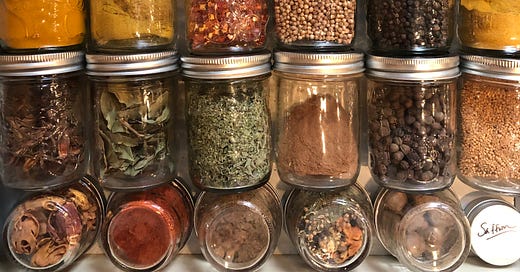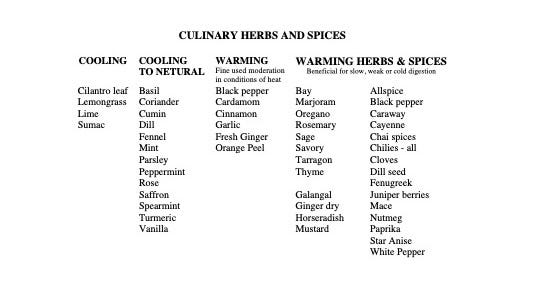Food as Medicine: Culinary Herbs and Spices Part One
An Introduction to Flavour and the Benefits of Culinary Herbs and Spices
You can access an audio recording of this post here
I love to eat. I love to eat food that tastes good. Truth be told, my favourite seasonings are salt, pepper and really good butter. Next in line would be my homemade rosemary salt and a pinch of chili pepper. I can be a very simple cook.
I spent a good chunk of my 30’s travelling Europe - A LOT. Which meant eating out A LOT - as well as becoming extremely innovative with kitchenette cooking while on the road. To this day, I rarely eat out. I think I kind of just got my fill of it. I got to hate the restaurants with complicated ways of preparing and presenting food. My favourite are the clean simple flavours of good food, prepared just right, with minimal added fuss. The true flavour of quality food, grown with care, speaks for itself. Those were the days of many food adventures.
I’ve always loved a good adventure. These days, when I need a bit of adventure, I might head to my kitchen and see what kind of interesting flavour could bring the world to my table. Much easier than having to travel elsewhere - especially these days. You can’t really call me an armchair traveller. Maybe more so a kitchen adventurer, where the flavours of the world inspire me with their heady and intoxicating scents and tastes.
Food is such an important expression of cultural heritage, our lineage, our origins. And flavours are so much tied into scent and our memory bank. Scent connects directly to our limbic system including the amygdala and hippocampus - which are the regions of the brain tied to memory and emotion. They reawaken in us a deep connection to our identity and our feeling body. What we eat and how we flavour our food is a profound expression of who we are and how we experience our world.
And this is also why the introduction of artificial food additives and flavour enhancers into our food supply is concerning to me. The food industry uses the power of taste and scent in a way that manipulates our taste buds to want to eat more of that which is not meant for us to want to eat. Garbage food. Empty calories. Food that damages not only our health, but our soulful connection to life itself.
Growing up, herbs and spices were were few and specific. My family immigrated to Canada from the Netherlands when I was child and like most immigrants, brought our culinary traditions with us. Soup was a cornerstone in our kitchen. My mother’s mantra when preparing her flavouring base for soup was “onions, carrot, celery, parsley”. The onions, carrot and celery carefully sautéed in butter to bring out their best flavours. This soup also carried the flavours of leek and perhaps lovage if celery was hard to come by. And of course, enough salt. You had to know how to salt the soup correctly or it would just taste off. And then, there was the “holy annointing'“ of the pot of soup with a single leaf of bay.
I never really understood bay leaf as a child. Those pale dry browned leaves did not carry much flavour or scent. It seemed more of an act of faith, or trust, that was necessary to make the soup whole. Or perhaps like casting a wish into that soup pot like a prayer. Many years later, having the good fortune of being gifted fresh bay leaves from a dear friend who tends a large bay tree, I now understand and love the nuance of bay. It’s one of my favourites, and I have been known to stuff the cavity of a roasting chicken with heads of garlic and handfuls of bay.
The main spices in our kitchen growing up, in addition to black pepper were powdered dry mustard for salad dressings, vanilla for baking, an occasional pinch of curry powder, and the infamous nutmeg. If there is one spice that exemplifies Dutch cooking, I would have to say it’s nutmeg. Nutmeg was used everyday. It was most often used to flavour cooked vegetables and cream sauces, and it was the main spice in the traditional sausage recipes I grew up with . It’s a relic of the messy colonial history the Dutch imposed upon Indonesia during their spice trade through the Dutch East Indies company more than 400 years ago.
While I usually think of Dutch cooking as relatively “bland”, this history left its mark. The curry powder I mentioned, was often used in my mother’s rendition of a traditional Indonesian dish called Nasi Goreng, complete with sambal - Indonesian hot sauce. The richly flavoured speculaas kruiden - kind of like pumpkin pie spice on steroids - lies testament to the relics of that spice trade as well. In it you will find the usual cinnamon, cloves, mace, ginger and nutmeg with the added complexity of cardamom, coriander, anise and white pepper. If you have ever tasted a speculaas cookie, you will know what I mean.
Garlic was not on the radar in the 70’s. At least not on my family table. It did finally make its appearance in our kitchen in the 80’s as we ventured forth into expanding our palates and our concept of health. My dad swore by garlic to keep his circulation top notch, and was known to crush a raw clove or two into his bowl of soup everyday.
When I finally ventured into my exploration of health and vegetarian eating, it was a bit of a learning curve. I still remember the first time I cooked lentils. It was a disaster. I just cooked them. And then I tried to eat them. I knew nothing other than that they were supposed to be good for me. Little did I know that lentils needed the rich flavours of herbs and spices to bring them into their glory. As I said, it was a bit of a learning curve.
Luckily that world of herbs and spices opened up for me. My interest in vegetarian cooking in my late teens led me to the Moosewood cookbooks which I have to say was my introduction to international flavours. One of my favourite food experiences of my life, was the summer of ‘89. Together with a few close girlfriends, all stationed in Ottawa on our respective work terms, we dove head first into the colours, flavours and scents of the world, through the doorway of Byward market and the ethnic restaurants in full bloom in the city at that time. What a flavour experience it was. And that’s where it all started.
A full rack of herbs and spices became second nature to me, fueled by the many life experiences and connections that came my way. Some of the most influential early on, came to me through my brother. With his love of food, culture, language and travel - I was introduced to the flavours of India and the Middle East. Creating my first Masala Dabba - Indian Spice Box - was such a joy. And appreciating the rich fullness of flavours that came from grinding whole spices fresh compared to the drab curry powder I grew up with. And the fresh herb flavours of Middle Eastern salads of dill, cilantro, parsley, mint and fresh lemon woke up my taste buds in ways I could not have imagined.
So began my exploration of the herbs and spices of the world. And to this day, when I am feeling a bit blah or bored with food, or life in general, I may turn to some cookbooks or recipe blogs that bring these flavours to my table.
Many of the recipes I share with you include a wide range of herbs and spices. I have come to appreciate the use of herbs and spices in cooking, not just for their flavour, but for their medicinal value. Influenced heavily by the concepts of Ayurvedic medicine around the importance of supporting our “digestive fire” as the key player necessary to maintain good health, many herbs and spices have an affinity to improving digestion. As well, Ayurveda is based on a brilliant framework of defining the energetics of different body types and the interplay of flavours and foods that help balance and support health and wellbeing.
THE BENEFITS OF CULINARY HERBS AND SPICES
I understand and appreciate simple flavours and a simple palate - flavour fueled mainly by the quality of the food itself. The many herbs and spices, not to mention spice mixtures from around the world can feel overwhelming and daunting, not only to try and procure, but also to integrate into one’s palate of comfort. Why on earth would we want to go to the trouble of complicating life and adding in more herbs and spices?
Here are some reasons to consider adding more herbs and spices into your diet:
The herbs and spices themselves have a significant impact on our health through their medicinal action on improving digestion directly. They improve the flow of digestive juices and improve our overall digestive function - maximizing the absorption of nutrients from our foods.
Just as important to improving our digestion is the enjoyment that comes from eating the food itself. We want to eat food that tastes good. When we are in the receptive state of enjoying food, our digestion just works better. And good digestion is the corner to good health. Herbs and spices, when used in a way that honours your taste buds, can make food taste great. This is important, especially when it comes to healthy eating. For some reason, we have this idea that healthy food is not enjoyable food. Herbs and spices can enhance our appetite and bring great enjoyment to the our food experience. Anything that will make us enjoy our food more is a win.
When we enjoy our food, it gives a feeling of satisfaction and opens up the gate ways for the “rest and digest” part of the nervous system to express itself fully. Eating good food brings a feeling of safety and connection. And when this part of nervous system is online - our digestive system functions optimally.
Herbs and spices can have a beneficial balancing effect on our gut microbiome (the balance of bugs in our gut) and they are among the richest source of a wide variety of healing plant compounds and phytonutrients.
Herbs and spices, when chosen according to our body’s unique energetics can have an important overall balancing effect on our health and wellbeing. One of the ways we can get to know which flavours are best for our body type is to listen to our palate and play with the various flavours to see what speaks to us most.
BUT MY KIDS DON’T LIKE SPICES
Often children are averse to strong flavours. I would suggest you might offer the option to add flavourings at the table according to one’s taste buds. Create a simple herb and spice flavour hub for the kitchen table and encourage family members to follow their taste buds. Flavour the main dish in a way that tastes good but does not use any overpowering spices. Allow family members to pick and choose according to their palate.
In our next post we will explore some the main flavours and how we can begin to include more of them in our foods.
You can access the second post in our series on Culinary Herbs and Spices here.







